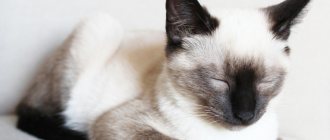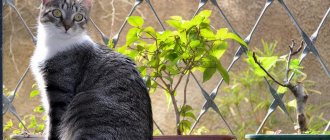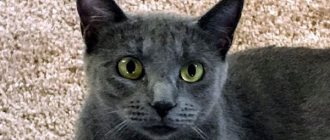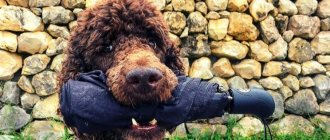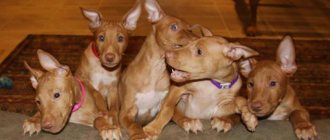The Scottish Fold is a young cat breed. The first kittens appeared a little over 50 years ago - in the 60s of the 20th century. Animals with folded ears quickly fell in love with buyers, first conquering Europe, and then moving to the United States.
One of the features due to which the black fold-eared cat has become the favorite of a large number of people is its straight stance. Imitating gophers, these animals like to sit on their hind legs, raising their body, and lowering their front legs. Only their goals are different - this is how the animals knead the bones of the spine.
Surprisingly, although the black fold cat belongs to the cat family, in most cases he is afraid of heights. This feature is due to the structure of the vestibular apparatus. But when playing, they do not jump on the curtains and rarely jump on cabinets. Fold-eared Scots love to play and fool around, but they will do it with dignity.
Story
The first animal of this breed, Susie, appeared in Scotland from a semi-wild cat. The father remains unknown.
Quite early, Susie began to bear offspring, which the owners had difficulty placing with friends. In 1963, a resident of Scotland, Mary Ross, received one of Susie's kittens as a gift - it was a white cat, nicknamed Snooks. Her first offspring revealed a kitten very similar to those we know today as Scottish Folds. It was a white cat with heavy paws, who was named Snowball. The owner did not have the skills of a breeder, but the woman thought that she had a chance to see the birth of a new breed.
After Snowball grew up, he was crossed with a British Shorthair. At the same time, in the next mating, Snooks was bred with a British blue. It was in this simple way that the first Scottish Fold cat was obtained at home. The black color of the first litter and folded ears attracted the interest of the breeders, who helped Mary develop the final breeding algorithm.
Over the past few decades, this breed has become one of the most sought after throughout the world. As a result of a malfunction in the gene pool that arose due to crossbreeding with short-haired cats, geneticists had to make a lot of effort to eliminate it. If both parents were lop-eared, such crossing sometimes led to disorders in the musculoskeletal system. This is what forced the use of partners of the Scottish breed who do not have folded ears in breeding.
The fold-eared black cat most often appears with normal ears. They fold only after four weeks after birth.
Color table
International system for determining the colors of folds and straights of Scottish cats, as well as Highlands. Information about the types of colors and the location of the pattern is enclosed in a code entry of numbers and alphabetic expressions. Numbers-colors, letters-designations.
Scottish cat color chart.
| A | Blue |
| b | Chocolate, brown, chestnut (Chocolate, brown, Havana, champagne) |
| With | Lilac, lavender (lilac, lavender, platinum) |
| d | Red, flame (red) |
| e | Cream |
| f | Tortoiseshell, atch (Tortoiseshell) |
| g | Blue-cream, blue-tortie (blue cream, blue tortoiseshell) |
| h | Chocolate-tortie (chocolate tortoiseshell) |
| j | Lilac-tortie (lilac tortoiseshell) |
| n | Black, ebony, seal, sable, ruddy (black, ebony, seal, sable, wild) |
| o | Sorrel, cinnamon, honey (sorrel, cinnamon, honey) |
| p | Beige-fawn (yellow-brown, beige) |
| q | Sorrel tortie (red brown tortoiseshell) |
| r | Beige fawn (yellow-brown, beige) |
| s | Silver, smoke (silver, smoky) |
| w | White |
| x | Unregistered (unregistered color) |
| y | Golden (golden) |
| 01 | Man (van) |
| 02 | Harlequin (harlequin) |
| 03 | Bicolor (two-color, bicolor) |
| 04 | Mitted, white-point (color point with white marks) |
| 09 | Little white spots (white spotting 1-2cm) |
| 11 | Tabby, agouti (striation, agouti factor) |
| 12 | Tipped, shell (veiled, i.e. 1/8 of the top part of the hair is darkened) |
| 22 | Blotched, marble |
| 23 | Mackerel, tiger (mackerel, tiger) |
| 24 | Spotted |
| 25 | Ticked (ticked or Abyssinian) |
| 31 | Burmese (Burmese) |
| 32 | Tonkinese (Tonkinese) |
| 34 | Singapura (Singaporean) |
Varieties of coat color, as well as eyes and tail length are indicated in numbers.
XXX.xx.NN.NN.NN.(NN); xx - color signs. XXX - designation of the animal breed; NN - numbers.
This precise classification of codes is convenient and is used in international clubs. It is interesting to watch the development of color in a small Scottish kitten. At birth, the baby may be a single color, after a month stripes appear, and the pattern changes with age. The stripes will either disappear or, on the contrary, darken and become more distinct.
The future appearance is determined by the shade of the nose and paw pads. The baby's former owner and the owner of the nursery that provided the baby will answer all your questions regarding the color of Scottish fold cats.
Source
Appearance
Light blue coat color is considered classic. But since a large number of different exotics took part in the formation of the breed, today a huge variety of colors is acceptable. Scots can be blue, cream, white, bicolor, black, tabby, chinchilla and so on.
The head of animals of this breed is round, with a flat forehead, drooping ears. The legs are relatively short, the paws are rounded. The nose is straight and wide. The fur is short and thick.
On average, a black fold cat weighs 8 kg.
Description of the breed
The appearance of the fold is unusual for an ordinary cat, primarily due to the shape of the ears .
- The ears are widely spaced on the slightly flattened head and seem to be tucked downwards.
- The eyes are set close to the nose and have a rounded forum. Eye color is most often brown, gold or sand.
- The nose is small, with a small hump and also has a black color.
- The body is proportional, not stretched, compact. Despite their toy appearance, these are strong animals, dexterous, fast and very agile. Paws are straight, covered with hair. The pads are soft and have fur on them that should be trimmed periodically.
- The head is slightly flattened, but in proportion to the body. Visually they appear clubfooted, but this does not in any way affect the dexterity of the animal.
- The British belong to the category of large cats, so the maximum weight for them is about ten kilograms.
- The coat is short, but very thick, which creates a fluffy or even plush effect.
Apart from color, black representatives of Scottish Folds are no different from their fellow tribesmen of other colors.
To read: Meet the green-eyed oriental beauty: Oriental Longhair
Intelligence
Animals are playful and quite active - this is especially true for kittens. They quickly get used to sitting in their owner's arms. The black fold cat is prone to basic training. These animals quickly figure out what purpose there is a scratching post in the house; some individuals are able to turn on and watch TV.
The intelligence of Scottish Folds is at a fairly high level, their intuition is well developed, and they are highly adaptable. These animals are able to quickly get used to any environment, “read” the owner’s emotions, adapting to his mood. Fold-eared pets are non-aggressive, they are almost unable to take revenge.
Character
The character of these animals is very stable, they do not give in to hysterics, quickly become attached to the house and owner, while being self-sufficient.
A striking feature of the breed is its voice. It does not at all resemble a gentle purr, but rather the creaking of old wood. Scots rarely shout, mostly communicating their needs in a polite manner.
In conflict situations, ordinary cats hiss, bite, and show aggression in every possible way. However, this does not apply to the Scots, who are born diplomats. If they could go to work, they would certainly get into politics!
Plain (solid)
This type of color implies a single rich shade of fur without ticking or patterns. Clear spots and hairs of a different shade are not allowed, which is quite difficult to achieve with a cream or red color. Such cats may have, but are undesirable, weak patterns on the tail, muzzle, paws, and less often on the body.
Solid colors are found in intense (black, red, chocolate) and diluted (marble, lilac, cream).
Scottish Fold - black (ebony) color
The color is mostly bright. Red, brown areas of the coat indicate a defect. Representatives of this color, considered mystical in ancient times, are not so rare among folds.
Scottish Fold - chocolate color
This beautiful coloring is not characterized by an undercoat of any other color, light hairs, or various patterns.
White
Snow-white with shine, no yellowness. In newborn babies, spots on the head are allowed to be bluish if there were blue ancestors in the family, or dark spots if one of the ancestors was black. In an adult, the fur becomes perfectly white.
Cinnamon
A rare warm color that looks no less impressive than rich chocolate.
Scottish Fold - color lilac (lavender)
Coffee with milk is how this exquisite, delicate shade of wool is characterized.
INTERESTING TO KNOW: Kurilian Bobtail: how to get a miniature lynx at home
Fawn
Kittens whose fur is colored in a touching soft beige shade (lightened cinnamon) look touching and cute.
Red
A rare color, implying the presence of an intense solid shade, evenly pigmented and distributed throughout the body. On the forehead and limbs, a faint pattern is acceptable, but undesirable. A light (red) tip of the tail is a breed defect.
Blue color (blue)
A classic color that allows for the entire blue color palette: both light and dark tones. The baby may have moire patterns, which will then disappear.
Cream
Diluted red with the addition of a delicate peach tone. A vague pattern on the forehead and legs is acceptable, but noticeable leopard markings are unacceptable.
Socialization
These animals get used to their family extremely quickly. Experienced owners are sure that cats treat children and elderly family members with special tenderness. If they really like a person, they will follow him everywhere, trying to attract attention. However, no matter how much they want to socialize, they will not distract from business by grabbing your legs or jumping on your lap. The most important thing for these cats is to be close to their loved one.
Other animals, including cats, please the Scots as they love good company. Even living together with a dog does not spoil the cats’ mood - they quickly get used to such a neighbor, playing with him and even caring for his fur.
Tortoiseshell colors
It is an original combination of red and dark or cream spots. This should not be confused with the tri-color pattern, as the cream color in the tabby pattern is a bleached red. There is no clearly defined standard regarding tortoiseshell color; the only condition is that the distribution of colors must be harmonious.
It is noteworthy that only cats have the rare tortoiseshell color. In cats, it is observed only in cases of genetic failures; such individuals are incapable of reproducing offspring.
Peculiarities
The high intelligence of cats of this breed indicates their good learning ability, however, screaming can forever discourage the animal from obeying. Moreover, a cat can become aggressive and cowardly if you shout at it regularly.
Fold-eared Scots do not tolerate rudeness. So, it will not be possible to carry cats of this breed by the scruff of the neck - they simply will not allow it. Firstly, because due to their severity, this position is painful for animals. Secondly, it is harmful to the spinal column. Cats need to be carried in such a way that all paws can rest on something in the air.
The owner must be extremely patient to raise a Scotsman. It is important to understand the individual characteristics of cats. For example, remember that even the smartest animal is not able to remember several commands. It is necessary to move from simple to more complex exercises.
Care
Most breeders talk about the low whimsical nature of cats of this breed. Their fur must be brushed daily with a massage brush. Animals get used to this quite quickly, enjoying the procedure that is beneficial for their health.
The fold-eared black cat, whose photo will decorate any catalog of breeds, contrary to stereotypes, does not resist bathing. Often gets used to water procedures after three to five times. Despite this, you can wash it only if absolutely necessary - if fleas appear or there is significant contamination.
The unique shape of the ears leads to the rapid accumulation of dust and wax in them. Therefore, you should inspect them regularly - 2-3 times a month. When cleaning, use a cotton swab coated with ear hygiene liquid.
Animals need to trim their claws no more than once a month - for this you should buy a steel nail clipper and a scratching post. The claw must be trimmed by 2 mm. You should not use scissors - this can harm the animal’s nerve endings or fingers.
Nicknames
Many owners, having acquired a new pet, are tormented by the question of what to name a fold-eared (black) cat. First of all, you should take into account that purebred animals have pedigrees and breeder marks. Each kitten is registered, so all animals from the same litter must have names starting with the same letter - this narrows the list.
The Scottish Fold (black) cat can be named anything, but most owners still prefer beautiful, sonorous nicknames that will sound good at exhibitions. For a home, purebred animals most often have a simpler, shorter and more convenient name. For example, King all Round at home may well turn out to be Bantik.
Bicolors
The color of a fur coat, in which a significant area of the coat is snow-white. The belly, chest, neck, chin, limbs, and muzzle must be white. Other shades are distributed evenly, without predominance in any area. The muzzle, like a royal sign, is decorated with a spot in the form of an inverted Latin “V”.
If there is an open white “collar” on the neck, the value of the animal increases.
The combination of snow-white is allowed with any of the available colors.
Diseases
Owners need to take care of the health of a cat prone to longevity. Despite the fact that the average lifespan of a lop-eared cat is 19 years, you need to regularly take them to the veterinarian and monitor their well-being at home.
First of all, you should monitor the cat’s appetite, sociability and behavior. If there are warning factors, it is necessary to check the temperature, take the pulse, and pay attention to other symptoms. If something bad happens to your animal, you should immediately consult a doctor.
